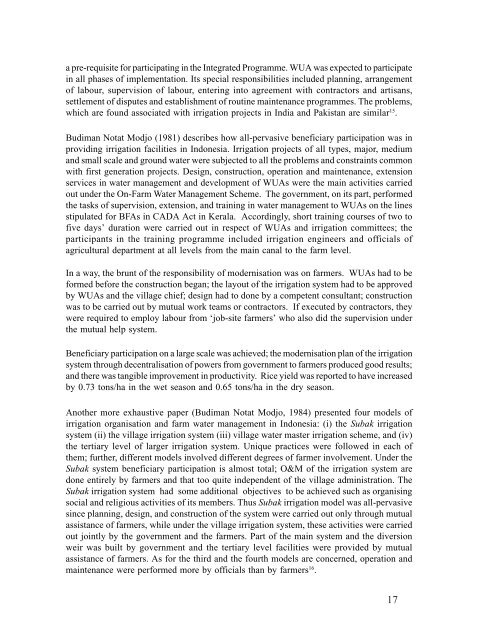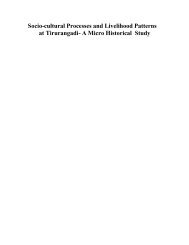Beneficiary Participation in Irrigation Water Management: The Kerala
Beneficiary Participation in Irrigation Water Management: The Kerala
Beneficiary Participation in Irrigation Water Management: The Kerala
You also want an ePaper? Increase the reach of your titles
YUMPU automatically turns print PDFs into web optimized ePapers that Google loves.
a pre-requisite for participat<strong>in</strong>g <strong>in</strong> the Integrated Programme. WUA was expected to participate<br />
<strong>in</strong> all phases of implementation. Its special responsibilities <strong>in</strong>cluded plann<strong>in</strong>g, arrangement<br />
of labour, supervision of labour, enter<strong>in</strong>g <strong>in</strong>to agreement with contractors and artisans,<br />
settlement of disputes and establishment of rout<strong>in</strong>e ma<strong>in</strong>tenance programmes. <strong>The</strong> problems,<br />
which are found associated with irrigation projects <strong>in</strong> India and Pakistan are similar 15 .<br />
Budiman Notat Modjo (1981) describes how all-pervasive beneficiary participation was <strong>in</strong><br />
provid<strong>in</strong>g irrigation facilities <strong>in</strong> Indonesia. <strong>Irrigation</strong> projects of all types, major, medium<br />
and small scale and ground water were subjected to all the problems and constra<strong>in</strong>ts common<br />
with first generation projects. Design, construction, operation and ma<strong>in</strong>tenance, extension<br />
services <strong>in</strong> water management and development of WUAs were the ma<strong>in</strong> activities carried<br />
out under the On-Farm <strong>Water</strong> <strong>Management</strong> Scheme. <strong>The</strong> government, on its part, performed<br />
the tasks of supervision, extension, and tra<strong>in</strong><strong>in</strong>g <strong>in</strong> water management to WUAs on the l<strong>in</strong>es<br />
stipulated for BFAs <strong>in</strong> CADA Act <strong>in</strong> <strong>Kerala</strong>. Accord<strong>in</strong>gly, short tra<strong>in</strong><strong>in</strong>g courses of two to<br />
five days’ duration were carried out <strong>in</strong> respect of WUAs and irrigation committees; the<br />
participants <strong>in</strong> the tra<strong>in</strong><strong>in</strong>g programme <strong>in</strong>cluded irrigation eng<strong>in</strong>eers and officials of<br />
agricultural department at all levels from the ma<strong>in</strong> canal to the farm level.<br />
In a way, the brunt of the responsibility of modernisation was on farmers. WUAs had to be<br />
formed before the construction began; the layout of the irrigation system had to be approved<br />
by WUAs and the village chief; design had to done by a competent consultant; construction<br />
was to be carried out by mutual work teams or contractors. If executed by contractors, they<br />
were required to employ labour from ‘job-site farmers’ who also did the supervision under<br />
the mutual help system.<br />
<strong>Beneficiary</strong> participation on a large scale was achieved; the modernisation plan of the irrigation<br />
system through decentralisation of powers from government to farmers produced good results;<br />
and there was tangible improvement <strong>in</strong> productivity. Rice yield was reported to have <strong>in</strong>creased<br />
by 0.73 tons/ha <strong>in</strong> the wet season and 0.65 tons/ha <strong>in</strong> the dry season.<br />
Another more exhaustive paper (Budiman Notat Modjo, 1984) presented four models of<br />
irrigation organisation and farm water management <strong>in</strong> Indonesia: (i) the Subak irrigation<br />
system (ii) the village irrigation system (iii) village water master irrigation scheme, and (iv)<br />
the tertiary level of larger irrigation system. Unique practices were followed <strong>in</strong> each of<br />
them; further, different models <strong>in</strong>volved different degrees of farmer <strong>in</strong>volvement. Under the<br />
Subak system beneficiary participation is almost total; O&M of the irrigation system are<br />
done entirely by farmers and that too quite <strong>in</strong>dependent of the village adm<strong>in</strong>istration. <strong>The</strong><br />
Subak irrigation system had some additional objectives to be achieved such as organis<strong>in</strong>g<br />
social and religious activities of its members. Thus Subak irrigation model was all-pervasive<br />
s<strong>in</strong>ce plann<strong>in</strong>g, design, and construction of the system were carried out only through mutual<br />
assistance of farmers, while under the village irrigation system, these activities were carried<br />
out jo<strong>in</strong>tly by the government and the farmers. Part of the ma<strong>in</strong> system and the diversion<br />
weir was built by government and the tertiary level facilities were provided by mutual<br />
assistance of farmers. As for the third and the fourth models are concerned, operation and<br />
ma<strong>in</strong>tenance were performed more by officials than by farmers 16 .<br />
17










